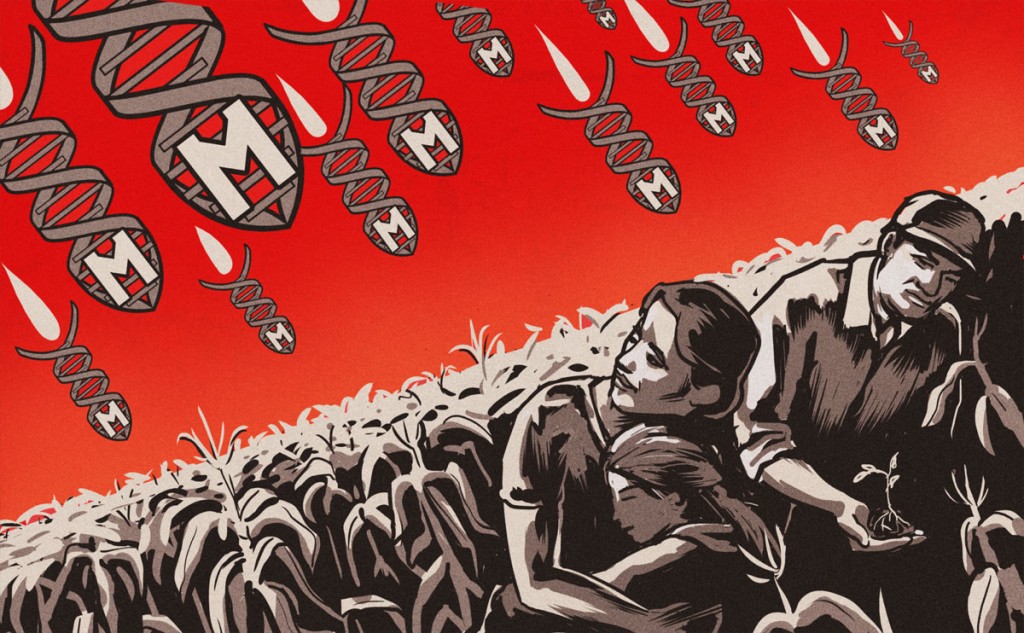by Dave Mihalovic
 The overuse of Monsanto’s Roundup herbicide on our food is causing glyphosate toxicity and it is now being considered as the single most important factor in development of autism and other chronic disease. At a recent panel discussion about GMOs, a senior scientist has stated that one in two children will be autistic by 2025.
The overuse of Monsanto’s Roundup herbicide on our food is causing glyphosate toxicity and it is now being considered as the single most important factor in development of autism and other chronic disease. At a recent panel discussion about GMOs, a senior scientist has stated that one in two children will be autistic by 2025.
Glyphosate does induce disease and is a “textbook example of exogenous semiotic entropy.” Glyphosate inhibits detoxification of xenobiotics and interferes with cytochrome P450 enzymes, which enhances the damaging effects of other chemical residues and toxins, and very slowly damages cellular systems in the body through inflammation. Residues of glyphosate are found in sugar, corn, soy, and wheat, some of the main components of the Western diet.
Autism is now a disorder that is officially being linked to several causes involving synergistic toxicity specifically between vaccines, our food, the environment and some degree of genetic susceptibility.
Common psyche drugs and vaccines require the Cytochrome P450 gene 2D6 in order to be metabolized. 2D6 refers to the most major metabolic liver enzyme. On the same gene, Cytochrome P450, is the Glutathione pathway implicated in Autism and vaccine injury.
Glyphosate also suppresses specific amino acids that represent up to 35% of a plant’s dry mass. In doing so, it effectively kills the pathway of bacteria. This in turn disrupts the gut bacteria of all mammals upon digestion.
For over three decades, Stephanie Seneff, PhD, has researched biology and technology, over the years publishing over 170 scholarly peer-reviewed articles. In recent years she has concentrated on the relationship between nutrition and health, tackling such topics as Alzheimer’s, autism, and cardiovascular diseases, as well as the impact of nutritional deficiencies and environmental toxins on human health.
“At today’s rate, by 2025, one in two children will be autistic,” she stated. She noted that the side effects of autism closely mimic those of glyphosate toxicity, and presented data showing a remarkably consistent correlation between the use of Roundup on crops (and the creation of Roundup-ready GMO crop seeds) with rising rates of autism. Children with autism have biomarkers indicative of excessive glyphosate, including zinc and iron deficiency, low serum sulfate, seizures, and mitochondrial disorder.
 A fellow panelist reported that after Dr. Seneff’s presentation, “All of the 70 or so people in attendance were squirming, likely because they now had serious misgivings about serving their kids, or themselves, anything with corn or soy, which are nearly all genetically modified and thus tainted with Roundup and its glyphosate.”
A fellow panelist reported that after Dr. Seneff’s presentation, “All of the 70 or so people in attendance were squirming, likely because they now had serious misgivings about serving their kids, or themselves, anything with corn or soy, which are nearly all genetically modified and thus tainted with Roundup and its glyphosate.”
Even low levels of one of the most widely used pesticides in the world, chlorpyrifos, frequently applied to crops of cotton, corn, almonds, and fruit trees including oranges and apples, leads to long-term, potentially irreversible changes in the brain structure of the child.
The real damage is in the Glyphosate, and always has been.
Even a quick search for scientific publications on glyphosate demonstrates its toxicity and carcinogenicity:
Glyphosate-Induced Carcinogenicity
http://www.ncbi.nlm.nih.gov/pubmed/20045496
Glyphosate’s Suppression of Cytochrome P450 Enzymes
http://www.mdpi.com/1099-4300/15/4/1416
Glyphosate Induces Human Breast Cancer Cell Growth
http://www.ncbi.nlm.nih.gov/pubmed/23756170
Cytotoxicity of the herbicide glyphosate
http://www.ncbi.nlm.nih.gov/pubmed/18320126
Biomonitoring of genotoxic risk in agricultural workers
http://www.ncbi.nlm.nih.gov/pubmed/19672767
Technical Factsheet on: GLYPHOSATE
http://www.epa.gov/safewater/pdfs/factsheets/soc/tech/glyphosa.pdf
One study, published in the journal Ecotoxicology, found that glyphosate is toxic to water fleas (Daphnia magna) at minuscule levels that are well within the levels expected to be found in the environment.
A recent regulation lets farmers use more of the chemical, which is the active ingredient in the herbicide Roundup. Oilseed crops such as canola, soy, sunflower, flax and peanuts can now contain up to 40,000 parts per billion (ppb) glyphosate which is almost 60 times the minimum containment level for drinking water which even the EPA admits causes organ damage and reproductive effects.
Dr. Seneff noted the ubiquity of glyphosate’s use. Because it is used on corn and soy, all soft drinks and candies sweetened with corn syrup and all chips and cereals that contain soy fillers have small amounts of glyphosate in them, as do our beef and poultry since cattle and chicken are fed GMO corn or soy. Wheat is often sprayed with Roundup just prior to being harvested, which means that all non-organic bread and wheat products would also be sources of glyphosate toxicity. The amount of glyphosate in each product may not be large, but the cumulative effect (especially with as much processed food as Americans eat) could be devastating. A recent studyshows that pregnant women living near farms where pesticides are applied have a 60% increased risk of children having an autism spectrum disorder.
This month, the USDA released a study finding that although there were detectable levels of pesticide residue in more than half of food tested by the agency, 99% of samples taken were found to be within levels the government deems safe, and 40% were found to have no detectable trace of pesticides at all. The USDA added, however, that due to “cost concerns,” it did not test for residues of glyphosate. Let’s repeat that: they never tested for the active ingredient in the most widely used herbicide in the world.“Cost concerns”? How absurd “unless they mean it will cost them too much in terms of the special relationship between the USDA and Monsanto. You may recall the revolving door between Monsanto and the federal government, with agency officials becoming high-paying executives and vice versa! Money, power, prestige: it’s all there. Monsanto and the USDA love to scratch each others’ backs. Clearly this omission was purposeful.
Monsanto claims that Roundup is harmless to humans. Bacteria, fungi, algae, parasites, and plants use a seven-step metabolic route known as the shikimate pathway for the biosynthesis of aromatic amino acids; glyphosate inhibits this pathway, causing the plant to die, which is why it’s so effective as an herbicide. Monsanto says humans don’t have this shikimate pathway, so it’s perfectly safe.
Dr. Seneff points out, however, that our gut bacteria do have this pathway, and that’s crucial because these bacteria supply our body with crucial amino acids. Roundup thus kills beneficial gut bacteria, allowing pathogens to grow; interferes with the synthesis of amino acids including methionine, which leads to shortages in critical neurotransmitters and folate; chelates (removes) important minerals like iron, cobalt and manganese; and much more.
Even worse, she notes, additional chemicals in Roundup are untested because they’re classified as”inert,”yet according to a 2014 study in BioMed Research International, these chemicals are capable of amplifying the toxic effects of Roundup hundreds of times over.
Glyphosate is present in unusually high quantities in the breast milk of American mothers, at anywhere from 760 to 1,600 times the allowable limits in European drinking water. Urine testing shows Americans have ten times the glyphosate accumulation as Europeans.
“In my view, the situation is almost beyond repair,” Dr. Seneff said after her presentation. “We need to do something drastic.”
Sources:
anh-usa.org
themindunleashed.org
preventdisease.com
Is Monsanto Causing Autism? 50% Affected by 2025
